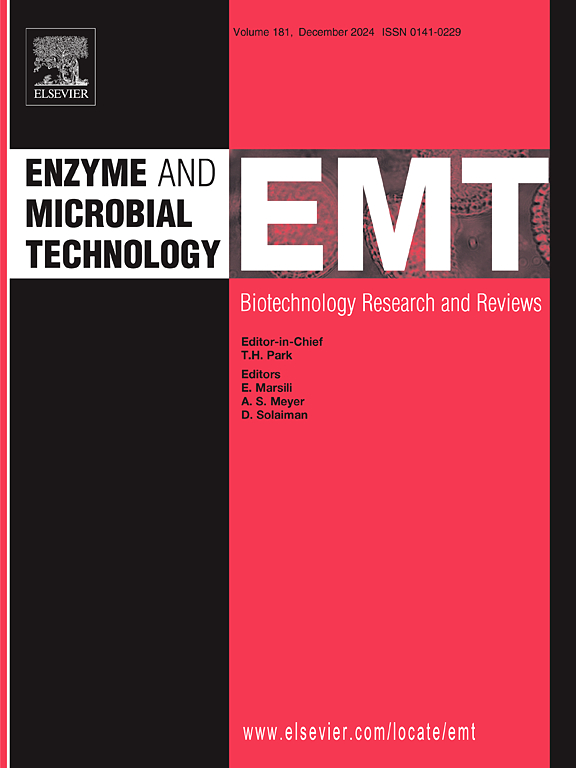Soluble and pocket engineering of D-amino acid oxidase and its application in the biotransformation of L-glufosinate
IF 3.7
3区 生物学
Q2 BIOTECHNOLOGY & APPLIED MICROBIOLOGY
引用次数: 0
Abstract
L-glufosinate (L-PPT) is a chiral herbicide with high herbicidal activity, environmental friendliness and significant market potential. The kinetic resolution of commercially available DL-PPT into optically pure L-PPT through four-enzyme one-pot biocatalysis presents a promising approach. D-amino acid oxidase (DAAO) catalyzes the conversion of D-PPT to 2-oxo-4-[(hydroxy)(methyl)phosphinyl] butyric acid (PPO), playing a critical role in the synthesis of L-PPT. However, the low solubility and enzyme activity of the wild-type DAAO limit its industrial applicability. In this study, we identified NcDAAO from Neurospora crassa OR74A, which exhibits high specific enzyme activity. First, the solubility of NcDAAO was significantly improved by combining N-terminal fusion tags with protein sequence truncation strategies, resulting in a 14.85-fold increase in enzyme activity. Subsequently, the modified variant was subjected to AlphaFold2 modeling, molecular docking and high-throughput screening. The V117N/Q325S variant demonstrated enhanced catalytic activity toward the substrate D-PPT. Finally, a one-pot biocatalysis was developed for the conversion of D-PPT to L-PPT, with the reaction completing within 3 hours and achieving an enantiomeric excess (ee) of > 99 %, highlighting the excellent catalytic performance of this variant in L-PPT synthesis.
d -氨基酸氧化酶的可溶性和袖珍工程及其在l -草铵膦生物转化中的应用
草甘膦(L-PPT)是一种具有高除草活性、环境友好、市场潜力巨大的手性除草剂。通过四酶一锅生物催化将市售DL-PPT动力学分解为光纯L-PPT是一种很有前途的方法。d -氨基酸氧化酶(DAAO)催化D-PPT转化为2-氧-4-[(羟基)(甲基)膦基]丁酸(PPO),在L-PPT合成中起关键作用。然而,野生型DAAO的溶解度和酶活性较低,限制了其工业应用。本研究从粗神经孢子虫OR74A中鉴定出具有较高特异酶活性的NcDAAO。首先,通过将n端融合标签与蛋白质序列截断策略结合,NcDAAO的溶解度显著提高,酶活性提高14.85倍。随后,对修饰变体进行AlphaFold2建模、分子对接和高通量筛选。V117N/Q325S变体对底物D-PPT的催化活性增强。最后,开发了一锅生物催化将D-PPT转化为L-PPT,反应在3 小时内完成,对映体过量(ee)达到>; 99 %,突出了该变体在L-PPT合成中的优异催化性能。
本文章由计算机程序翻译,如有差异,请以英文原文为准。
求助全文
约1分钟内获得全文
求助全文
来源期刊

Enzyme and Microbial Technology
生物-生物工程与应用微生物
CiteScore
7.60
自引率
5.90%
发文量
142
审稿时长
38 days
期刊介绍:
Enzyme and Microbial Technology is an international, peer-reviewed journal publishing original research and reviews, of biotechnological significance and novelty, on basic and applied aspects of the science and technology of processes involving the use of enzymes, micro-organisms, animal cells and plant cells.
We especially encourage submissions on:
Biocatalysis and the use of Directed Evolution in Synthetic Biology and Biotechnology
Biotechnological Production of New Bioactive Molecules, Biomaterials, Biopharmaceuticals, and Biofuels
New Imaging Techniques and Biosensors, especially as applicable to Healthcare and Systems Biology
New Biotechnological Approaches in Genomics, Proteomics and Metabolomics
Metabolic Engineering, Biomolecular Engineering and Nanobiotechnology
Manuscripts which report isolation, purification, immobilization or utilization of organisms or enzymes which are already well-described in the literature are not suitable for publication in EMT, unless their primary purpose is to report significant new findings or approaches which are of broad biotechnological importance. Similarly, manuscripts which report optimization studies on well-established processes are inappropriate. EMT does not accept papers dealing with mathematical modeling unless they report significant, new experimental data.
 求助内容:
求助内容: 应助结果提醒方式:
应助结果提醒方式:


